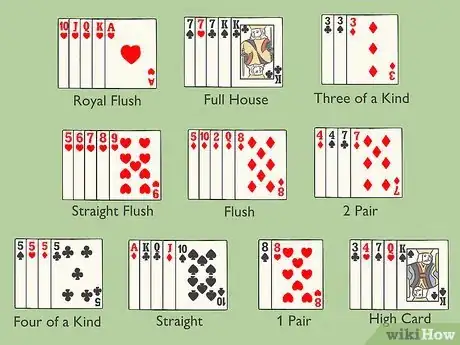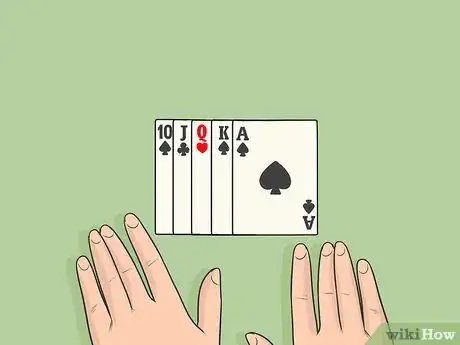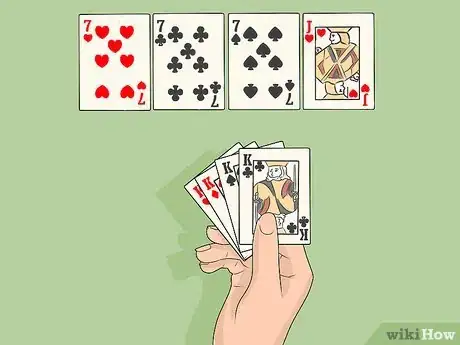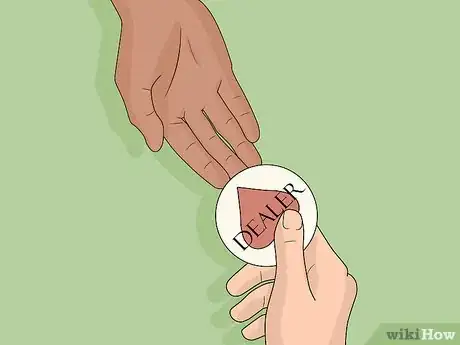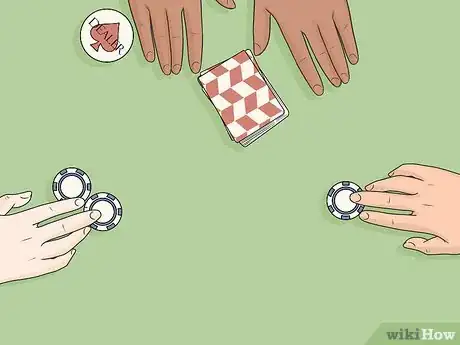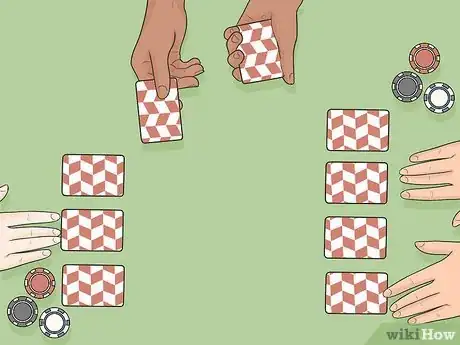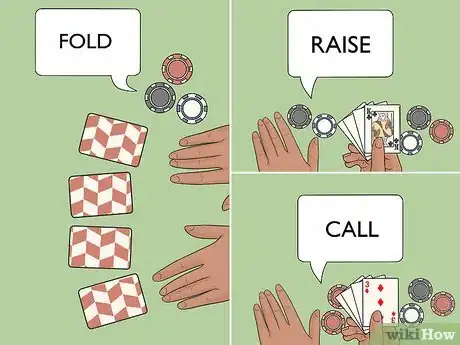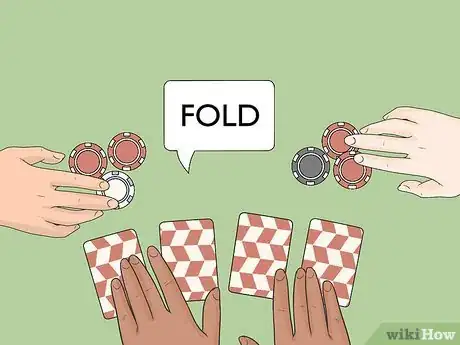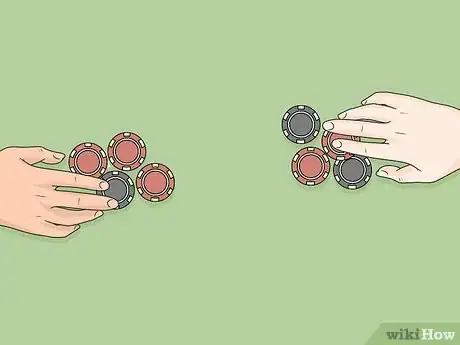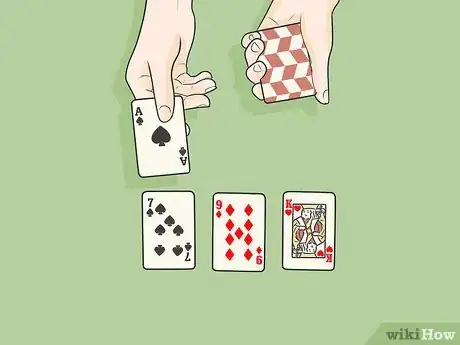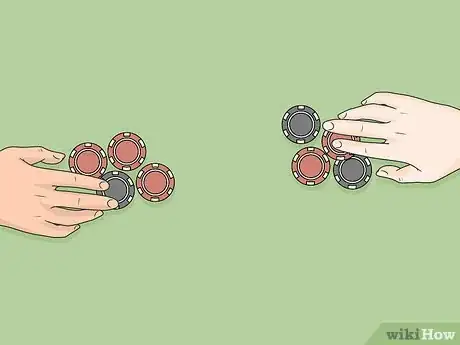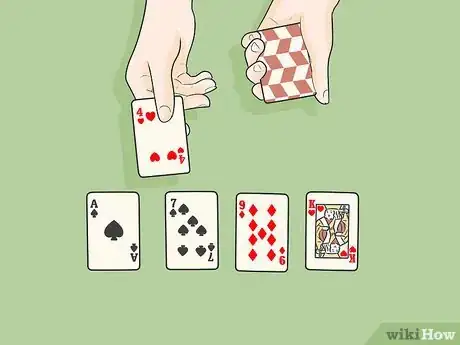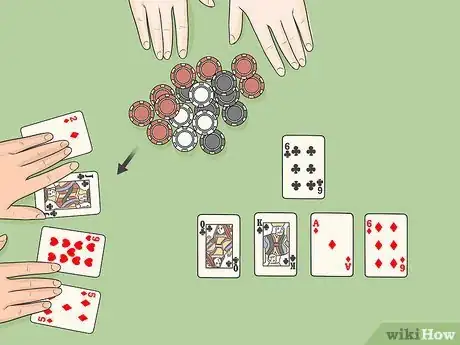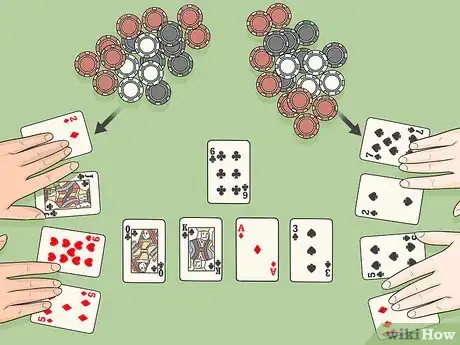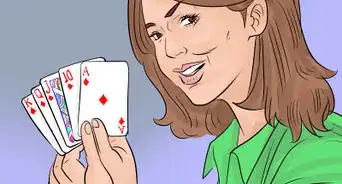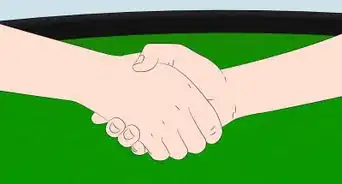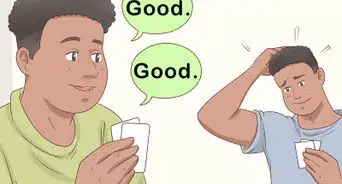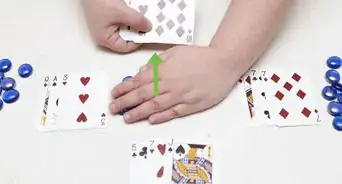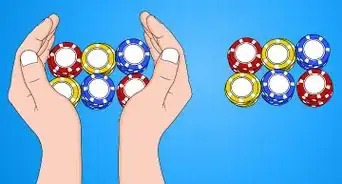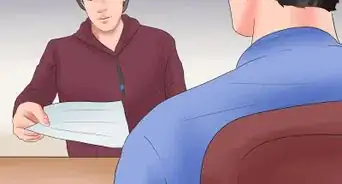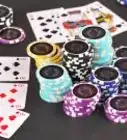This article was co-authored by wikiHow staff writer, Kyle Hall. Kyle Hall works on the content team at wikiHow. He helps manage our team of editors and creates content for a variety of wikiHow projects. Kyle continually looks for new ways to improve the content at wikiHow and make it more helpful and enjoyable for readers. He graduated from Eckerd College in 2015, where he majored in Political Science.
This article has been viewed 28,141 times.
Learn more...
Omaha poker is a community poker game where players have to make their best 5-card poker hand using both face-down and face-up cards. Similar to Texas Hold’em, the community cards in Omaha poker are dealt in 3 stages, and players bet after each stage. Learning how to play Omaha poker might seem overwhelming at first, but once you know all of the hand rankings and how the betting works, you’ll be having fun in no time. Betting and the way the pot is awarded varies slightly depending on whether you’re playing Pot-Limit Omaha or Omaha Hi Lo, but the basic rules and mechanics of each game are the same.
Steps
Learning the Basics
-
1Memorize the hand rankings for poker. The hand rankings in Omaha poker are the same as the rankings in other kinds of poker, like Texas Hold’em. To play Omaha poker, you’ll need to know which poker hands are better than others so you can bet accordingly. The hand rankings in order from best to worst are:[1]
- Royal flush: 10, jack, queen, king, and ace in the same suit.
- Straight flush: any straight in the same suit, like 5, 6, 7, 8, and 9 of hearts.
- Four of a kind: 4 cards of the same rank.
- Full house: 3 cards of the same rank plus 2 cards of the same rank.
- Flush: any 5 cards that are the same suit.
- Straight: 5 cards that are consecutive in rank, like 3, 4, 5, 6, and 7.
- Three of a kind: 3 cards of the same rank.
- Two pair: 2 cards of the same rank plus 2 different cards of the same rank.
- One pair: 2 cards of the same rank.
- High card: can be any card, but the higher the better (ace is the highest).
-
2Try to have the best 5-card poker hand to win the pot. At the end of each round, the player with the best 5-card hand wins. In Omaha poker, you get to make your own hand using the cards that you’re dealt as well as the community cards that are dealt face up on the table, which are available to all players. At the end of each round, you want to choose the cards in your hand and on the table that will give you the best hand ranking.[2]
- If you’re playing Omaha Hi Lo, there are 2 winners at the end of each round: the player with the highest hand, and the player with the lowest hand. In that case, instead of trying to get the best 5-card hand, you could try to get the lowest.
Exception: If all of the players except for one fold before a round is finished, the last player remaining automatically wins the pot, regardless of the hand they have.
Advertisement -
3Use 2 cards from your hand and 3 community cards to make your poker hand. In Omaha poker, each player is dealt 4 cards face down (these cards are called your “hole cards”). Then, as the game progresses, 5 community cards are played face up on the table. When you make your best hand at the end of each round, you must use 2 of your hole cards and 3 of the community cards.[3]
- For example, if you were dealt 4 kings face down, you would only be able to use 2 of them to make your best hand. Alternatively, if there were 4 kings face up on the table, you’d only be able to use 3 of them to make your best hand.
Starting the Game
-
1Give the dealer button to one of the players. Like Texas Hold’em, Omaha poker has a dealer button, which is a chip that gets passed around clockwise throughout the game. When you’re playing Omaha poker at home, the player with the dealer button is responsible for dealing out the cards at the beginning of each round.[4]
- If you’re playing at a casino, the dealer doesn’t change (it’s always the casino employee working the table), but the button still gets passed around and is used to indicate who goes first.
-
2Wait for the 2 players to the left of the dealer to post the blinds. A blind is a starting bet that’s used to force everyone to bet if they want to stay in that round. In Omaha poker, there’s a small blind and a big blind. The player immediately to the left of the dealer button plays the small blind, and the player to their left plays the big blind.[5]
- If you’re playing at a casino, the value of the small and big blinds is usually predetermined. If you’re playing at home, you can agree with the other players what you want the blinds to be, like $1.00 for the small blind and $2.00 for the big blind. Just keep in mind that the minimum bet is always equal to the big blind.[6]
- The small blind is usually half the value of the big blind.
- If it’s your turn to post a blind, place it on the table where you’d normally place your bet.
-
3Let the dealer pass out 4 cards face down to each player. The deal starts with the player to the left of whoever is holding the dealer button. From there, it continues clockwise. The dealer should deal 1 card to a player at a time, dealing each player a second card on their second time around the circle, and so on, until every player has 4 cards.[7]
- If you’re playing at a casino, the employee working the table will take care of this for you. If you’re playing at home, the player with the dealer button should deal out the cards.
Playing a Round
-
1Wait for the player to the left of the dealer button to call, raise, or fold. The player to the left of the dealer button should look at their face-down cards (without showing them to anyone else) and decide if they want to bet or fold. At this point, there won’t be any face-up community cards, so they’ll need to decide based on their hole cards only. If they call or raise, they should put their bet in the center of the table. If they fold, they should discard their cards.[8]
- Remember that the minimum bet is always equal to the big blind. Therefore, if the first player wants to stay in, they’d need to bet at least what the big blind is worth.
- For example, if the big blind is $2.00, the first player could call by betting $2.00 or raise by betting more than that.
- If you’re playing Pot-Limit Omaha, the maximum bet is equal to the size of the pot. For example, if there’s $5.00 in the pot (including the blinds), the most you could bet would be $5.00.
-
2Continue the betting clockwise until everyone has called, raised, or folded. The person to the left of the first player would bet, then the next player to the left would do the same, and so on. The player with the dealer button will bet last.[9]
- If you're playing Omaha Hi Lo, there is no limit to how much you can bet on your turn, as long as it's at least as much as the big blind.
-
3Have the dealer deal 3 cards face up on the table. These 3 cards are known as the “flop,” and they’re the first 3 community cards. The dealer should place them face up in the center of the table so all of the players can see them.[10]
Tip: Remember that community cards can be used by every player, and you have to use 3 of them, no more and no less.
-
4Let all of the players who haven’t folded bet again. Go around the circle again, starting with the player to the left of the dealer (unless that player has folded, in which case the next player to the left bets). Now that there are community cards face up on the table, you and the rest of the players can start to get a better sense of what kind of hand you have.[11]
- If at any point in the game all of the players fold except for one, the last player in automatically wins and collects the pot.
-
5Have the dealer deal 1 additional card face up on the table. This card is called the “turn,” and it should be placed face up next to the first 3 community cards.[12]
- At this point, there should be 4 community cards on the table.
-
6Wait for all of the remaining players to bet again. The betting continues in the same way, going around the table clockwise. Only the players who haven’t folded yet can still bet.[13]
- Remember that you have 3 options when it’s your turn to bet. You can call by matching the previous player’s bet, raise by betting more than them, or fold and discard your cards.
-
7Have the dealer place 1 final face-up card on the table. The final community card is called the “river.” Once the dealer deals the final community card, there won’t be any more cards dealt for that round.[14]
-
8Let the remaining players bet one last time. If you’re still in for the round, look at your hole cards and the community cards, and determine what the best 5-card poker hand you can make is. Remember that you have to use 2 of your hole cards and 3 of the community cards.[15]
- If you think you have a better hand than everyone else, bet high to raise the pot so you win more money. Alternatively, if you don’t think you’ve got a good hand, it might be best to fold since you won’t get any more cards that round.
Winning a Round
-
1Have all the players who are still in turn their hole cards face up. Then, look around the table to see what hands the other players have.[16]
- If you’ve already folded, you can just sit this part out until the following round.
-
2Give the pot to the player with the best hand if you’re playing Pot-Limit Omaha. In Pot-Limit Omaha, it’s winner-takes-all. Whichever player has the highest-ranking poker hand collects all of the money in the pot, and a new round begins.[17]
Tip: If there’s a tie, the pot is split between the winners.
-
3Award a best-hand and low-hand winner if you’re playing Omaha Hi Lo poker. In Omaha Hi Lo poker, there are 2 winners: the player with the best hand, and the player with the lowest hand. Each winner gets half the pot. To win the best-hand portion of the pot, you have to have the highest-ranking poker hand out of all the remaining players. To win the low-hand portion of the pot, you have to have the lowest hand, with ace being the lowest card.[18]
- To qualify for the low-hand pot, all of the cards in your 5-card hand have to be 8 or less, and you can’t have any pairs.
- It’s OK if the cards in your low hand make a straight or a flush, as long as the cards themselves are the lowest. For example, 5, 4, 3, 2, and ace is the lowest hand you can get, but it’s also a straight.
- If no player qualifies for the low-hand pot, the entire pot goes to the player with the best hand.
References
- ↑ https://www.pokernews.com/poker-hands.htm
- ↑ https://www.pokernews.com/poker-rules/omaha-poker.htm
- ↑ https://www.pokernews.com/poker-rules/omaha-poker.htm
- ↑ https://www.pokerlistings.com/poker-rules-omaha
- ↑ https://www.pokerlistings.com/poker-rules-omaha
- ↑ https://www.pokernews.com/poker-rules/texas-holdem.htm
- ↑ https://www.pokerlistings.com/poker-rules-omaha
- ↑ https://www.pokernews.com/poker-rules/texas-holdem.htm
- ↑ https://www.cardplayer.com/rules-of-poker/how-to-play-poker/games/omaha
- ↑ https://www.cardplayer.com/rules-of-poker/how-to-play-poker/games/omaha
- ↑ https://www.cardplayer.com/rules-of-poker/how-to-play-poker/games/omaha
- ↑ https://www.cardplayer.com/rules-of-poker/how-to-play-poker/games/omaha
- ↑ https://www.pokernews.com/poker-rules/texas-holdem.htm
- ↑ https://www.pokernews.com/poker-rules/texas-holdem.htm
- ↑ https://www.pokernews.com/poker-rules/texas-holdem.htm
- ↑ https://www.pokernews.com/poker-rules/omaha-poker.htm
- ↑ https://www.pokernews.com/poker-rules/omaha-poker.htm
- ↑ https://www.pokernews.com/poker-rules/omaha-hi-lo.htm
